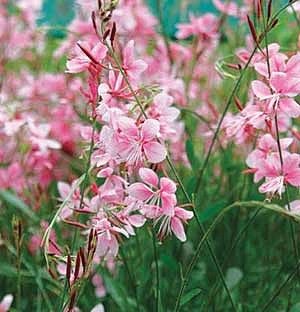
Garden News
September can be a great time of year in the garden as the late summer perennials put on their show in conjunction with the ornamental grasses. The low light in the mornings and evenings create great effects as the sun shines through the plants creating silhouettes and shadows that are not seen any other time of the year. The low light in the mornings and evenings create great effects as the sun shines through the plants, creating silhouettes and shadows that are not seen any other time of the year. It’s a time to wind down a bit in the garden but don’t take your foot off the throttle just yet as there will soon be plenty to do as the plants fade and we slowly head towards winter.Plant of The Month – Gaura Lindheimerii
At the end of summer, when everything starts to look a bit dejected, Gaura lindheimeri is just the kind of plant you want to create a touch of light, grace and charm amongst the big brutish perennials in our borders during late summer. Being relatively new as a cultivated plant used in our gardens, Gaura could be considered a teenager among the stately daisies and dahlias of September. However, its flowers have all the grace of spring and if used with confidence, it can steal the show from the traditional favourites at this time of year.
Gaura, also known as wandflower, whirling butterflies, and bee blossom, means superb and this plant has inspired nurserymen to christen new varieties with many a romantic name. One example of this would be 'Whirling Butterflies' – one of my favourites. Gaura lindheimeri can range from 15 inches to four feet tall, but most new cultivars are bred to be compact and container friendly. In Texas and Mexico, where it is a native plant, Gaura grows 3ft high and 3ft wide and plentiful. In the UK you would be lucky to get it past 2ft and to do that you will need to give it a place in the bright sunshine with well-drained soil.
Gaura flowers are generally pinky-white flowers which cluster on its thin stems. They go on appearing for months and best of all, they do not need dead-heading. It makes a stunning edging plant and can be very versatile as it works well in so many different types of schemes. It takes easily from cuttings and propagates easily from seed too. Sometimes this is the only way to ensure its longevity in the garden, as it’s not a long lived perennial and can easily die off through the winter if not given the perfect conditions for it to grow,
The airy texture and form of gaura plants make them lovely accent plants in the mixed perennial border. If planted en masse in the wildflower garden, you will soon see how they would have been named “whirling butterflies” as they dance in the breeze.
My favourite combination of all has to be a simple pairing of Penisetum Orientale and Gaura “Whirling Butterflies”. However, this little plant holds its own wherever you plant it. It can be great in containers, it works well in a traditional scheme planted with roses helping to provide colour when the roses rest in mid summer but best of all it shines bright amongst all those great late summer performers. Plant with Echinacea, Aster, Rudbeckia, Hellenium, Miscanthus and Panicum and you will be rewarded with a late summer display that keeps on going until the frosts arrive in early winter.
Jobs to do this month include:
Ornamental Garden:
• Continue to deadhead.
• Trim Lavenders to woody growth to keep them compact.
• Begin to clear leaves as necessary.
• Keep borders clear of weeds.
• cuttings of tender perennials.
• Continue to deadhead bedding plants
• Plan for next year’s garden displays.
• Collect seed from perennials / hardy annuals.
• Start planting spring bulbs
• Lift and divide herbaceous perennials.
• Start planting trees and shrubs towards the end of the month and move evergreen shrubs etc while the soil is still warm.
• Collect and get rid of any infected roses leaves.
Vegetable Garden:
• Once the tassels on sweet corn has turned brown check whether the cobs are ready to harvest. When ripe the kernels contain a milky liquid.
• Leave marrows, squashes, pumpkins etc to ripen on the plant. Place fruit on a wooden board to prevent soiling.
• Plant onions / shallots suitable for over wintering (on heavy wet soils spring planting may be preferable).
• Continue harvesting fruit.
• Harvest main crop potatoes.
• Sow winter greens such as land cress, mustard spinach, corn salad and hardy lettuce cultivars.

